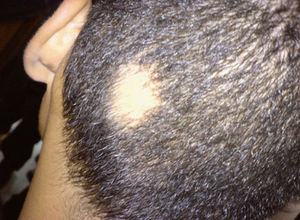Disproportionate Effect of Alopecia Areata, Alopecia Subtypes on Asian Americans

[ad_1]


Asian American, Black, and Hispanic patients may have a higher prevalence of alopecia areata (AA) and its subtypes, according to a recent cross-sectional study.1
An inflammatory skin disorder, alopecia and its subtypes (alopecia totalis and alopecia universalis) may lead to nonscarring patches of hair loss or even loss of scalp or body hair.
Key Highlights
- A cross-sectional study of electronic health records from 2019 found a significant burden of AA, AT, and AU in the US
- The age-and-sex standardized prevalences among adults and children/adolescents were 0.18% and 0.10%, respectively
- Prevalence was highest in those aged 30-49 and in Asian patients, followed by patients reporting another race/multiple races, Black, and Hispanic/Latino patients
- Patients of color, particularly Asian Americans, appear to be disproportionately affected by AA
Its prevalence, dramatic effects on life quality, and lack of data on demographic prevalence are the reasons for the investigators’ research in this topic. This study was authored by Nene Sy, BS, from the Department of Dermatology at Northwell Health in New York.
“The purpose of this study was to estimate overall prevalence of AA in the health care seeking population, as well as in specific demographic groups in the US,” Sy and colleagues wrote. “We also aimed to estimate overall and subgroup prevalence of AT and AU.”
The investigators conducted a cross sectional study with data collected from the Explorys database. This is a multi-health system research platform containing electronic medical record data of around 53 million unique patients from 4 different census regions in the US.
The research team’s data concerned adults and adolescents, with data collection being drawn from the period between January of 2019 and December of 2019 and statistical analysis being done between July of 2022 and December of 2022.
The investigators included patients who had at least a single healthcare encounter at a participating institution in 2019 and a minimum of 90 days of person-time in the data collection period. The patients were considered “observable” by the team from the date of their first encounter until their last recorded meeting reported in the database.
The research team reported that 1,093,176 patients had met the inclusion criteria, with 1,812 reporting at least 1 code for AA, 1,216 of patients with AA being female (67%) and 596 patients being male (33%).
They noted that overall standardized prevalence rates for age and sex were found to be 0.18% in adults and 0.10% in both children and adolescents, and that 1.32 was the age-standardized prevalence ratio in women to men.
The team also added that among the group aged 30 to 39 and the group aged 40 to 49, standardized prevalence was found to be the highest.
Overall, they concluded that the highest standardized prevalence was seen among Asian AA patients (414 per 100,000). This was followed by patients reporting another race or multiple races (314 per 100,000), then Black patients (226 per 100,000), and Hispanic patients (212 per 100,000).
White AA patients were found to have the lowest standardized prevalence (168 per 100,000) among each of the different subgroups assessed.Standardized prevalence ratios—relative to White AA patients—for Asian, Black, and Hispanic patients were 2.47, 1.35, and 1.26, respectively.
Around 9% of patients diagnosed with AA involved cases of AT and AU, according to the team’s findings.
“Few population-based studies explore overall and subgroup prevalences of AA in the US. Information on AA prevalence among demographic subgroups is further limited,” they wrote. “These studies are limited by self-report of diagnosis, selected cases (ie, only female participants) or controls, and restriction of subgroup analysis due to low case counts, which reduces generalizability to the broader population in the US.”
- Sy N, Mastacouris N, Strunk A, Garg A. Overall and Racial and Ethnic Subgroup Prevalences of Alopecia Areata, Alopecia Totalis, and Alopecia Universalis. JAMA Dermatol. Published online March 01, 2023. doi:10.1001/jamadermatol.2023.0016.
[ad_2]
Source link
